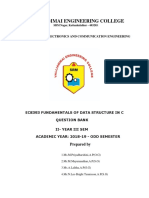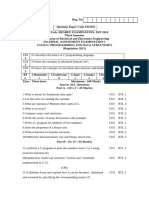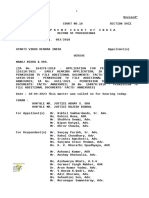CS6001-C Sharp and .NET Programming - 2marks - 2013 - Regulation
Uploaded by
YuvashreeCS6001-C Sharp and .NET Programming - 2marks - 2013 - Regulation
Uploaded by
YuvashreeDEPARTMENT OF INFORMATION TECHNOLOGY
Academic Year 2015-2016
QUESTION BANK-EVEN SEMESTER
NAME OF THE SUBJECT C# and .NET Programming
SUBJECT CODE CS6001
SEMESTER VI
YEAR III
DEPARTMENT IT
UNIT 1
PART – A
Q.No. Question Competence Level
List some of the new features that are unique to c#
1. language? Remembering BTL 1
State few words about the two important entities of .NET
2. frame work Remembering BTL 1
What is .NET? Name any 4 applications that are
3. supported by .Net framework. Remembering BTL 1
How will you determine the operator’s value?
4. Remembering BTL 1
What is the significance of MSIL?
5. Remembering BTL 1
What is an immutable string? How can we modify such a
6. string? Remembering BTL 1
Differentiate Const. and read only
7. Understanding BTL 2
Compare value type and reference type.
8. Understanding BTL 2
Compare array with structure.
9. Understanding BTL 2
BRS/IT CS 6001‐C# Page 1 of 13
www.studentsfocus.com
How managed codes differ from unmanaged codes
10. Understanding BTL 2
What are the major categories of data types in C#
11. Applying BTL 3
Illustrate with an example the implicit and explicit
12. conversions? Applying BTL 3
Relate Boxing and unboxing, provide suitable example for
13. each. Applying BTL 3
What are the differences between classes and structures?
14. Analyzing BTL 4
Why do we use methods as members of a struct?
15. Analyzing BTL 4
How does an Array List differ from Array
16. Analyzing BTL 4
Can an array hold objects of varying types? Explain how.
17. Evaluating BTL 5
Decide when concurrent programming is chosen for
18. application development. Evaluating BTL 5
Develop an application with jagged arrays?
19. Creating BTL 6
What if the language Java is considered instead c# for an
20. application development Creating BTL 6
PART-B
Q.No. Question Competence Level
i) Describe in detail about various operators available in
C#.
1. Remembering BTL 1
ii) Explain with example structures and enumerations.
i) Briefly note on control structures in C# with suitable
examples.
2. Remembering BTL 1
ii) What are arrays? Explain the types of arrays.
i) Write a short note on mutable strings with example.
3. ii) Explain the different types of expressions used in C# Remembering BTL 1
in detail.
BRS/IT CS 6001‐C# Page 2 of 13
www.studentsfocus.com
i) Describe in detail the role of Common Language
Runtime (CLR) in .NET.
4. ii) Brief with example the processes boxing and Understanding BTL 2
unboxing.
i) Discuss the command line compilation of C#.
ii) Explain how you will use primitive data types in code.
5. Understanding BTL 2
Demonstrate with example.
i) Explain with example structures and enumerations.
ii) Create an array of 10 integers. Populate the array by
having the user enter integers at the console (Console
6. Applying BTL 3
Readline) Output the integers sorted from the greatest
to least.
i) Explain with example enumerations and arrays in C#.
ii) Discuss the type of parameter passed to methods of Applying BTL 3
7.
C#. Analyzing BTL 4
i).Write a program that assigns the value 25 to variable x
and 5 to variable y. Output the sum, difference, quotient,
product and modulus of x and y.
ii).What will be the output of the following method?
Why?
Static void Main ()
{
8. Analyzing BTL 4
intvarA = 5;
intvarB = ++varA;
intvarC = varB++;
Console.WriteLine(“A:{0}, B:{1}, C:{2}”,varA,
varB, varC);
}
i) Explain the salient features of .NET framework.
9. ii) Explain the important characteristics of C# in detail Evaluating BTL 5
i)Develop a C# code to find the sum of all the elements
of a jagged array
10. Creating BTL 6
ii)Write a C# code to compare two strings using
"Equals" method.
BRS/IT CS 6001‐C# Page 3 of 13
www.studentsfocus.com
UNIT II
PART – A
Q.No. Question Competence Level
What is inheritance and explain the use of new keyword in BTL 1
1. C# inheritance. Remembering
Define Polymorphism. BTL 1
2. Remembering
Define a constructor and list its different types.
3. Remembering BTL 1
What are the uses of indexers
4. Remembering BTL 1
Define Delegates.
5. Remembering BTL 1
What are the uses of namespaces?
6. Remembering BTL 1
Discuss about exceptions and Name any four system
7. defined exceptions. Understanding BTL 2
Differentiate errors from exceptions.
8. Understanding BTL 2
List the difference between abstract classes and
9. interfaces? Understanding BTL 2
Give an example for virtual method and polymorphism.
10. Understanding BTL 2
What is the relationship between specialization and
11. generalization? Applying BTL 3
Discuss about multicast delegate?
12. Applying BTL 3
Illustrate with an example the call to a base class
13. constructor from a derived class? Applying BTL 3
Arrange atleast three important features of properties.
14. Analyzing BTL 4
BRS/IT CS 6001‐C# Page 4 of 13
www.studentsfocus.com
Point out the methods through which reusability is
15. achieved in C#. Analyzing BTL 4
Differentiate Multitasking and Multithreading
16. Analyzing BTL 4
Justify that Operators need to be overloaded. List the
17. operators that can be overloaded? Evaluating BTL 5
What support is provided by c# for events?
18. Evaluating BTL 5
What if there are no sealed classes in c#
19. Creating BTL 6
Develop a c# application with method hiding
20. Creating BTL 6
PART-B
Q.No. Question Competence Level
i) What do you mean by delegates? State their use with an
example.
1. ii) Explain the process of handing events through Remembering BTL 1
delegates.
i)Define an abstract class and explain the role of abstract
classes in an application development
2. ii). Explain with an example multitasking and Remembering BTL 1
multithreading in c#.
i) What are abstract classes and how to implement their
interfaces?
3. Remembering BTL 1
ii) Brief note on Defining operator pairs and implementing
an operator.
i)Describe how C# support multiple inheritance? Explain
4. by giving an example. Understanding BTL 2
ii) Describe the use of properties with an example.
i) Discuss briefly about interfaces with example.
ii) Write a program to find area of various shapes like
5. Understanding BTL 2
rectangle, circle and triangle using the concept of
interfaces.
i)Demonstrate both sealed classes and sealed methods
6. with example program Applying BTL 3
ii) Illustrate with an example how the events are generated
BRS/IT CS 6001‐C# Page 5 of 13
www.studentsfocus.com
and handled in c#.
i)Explain exception handling in C#. Applying
BTL 3
7. ii) Write user defined exception for overflow and stack Analyzing
BTL 4
empty exceptions in a Stack class.
i) Write a brief note on comparing Properties, Arrays and
8. Indexes. Analyzing BTL 4
ii) Compare and contrast Indexes and delegates
i) Explain about the concept of operator overloading in
detail.
ii) Consider a student class with feet and inches as
9. Evaluating BTL 5
attributes which describes the height of the student.
Write a C# program to overload the + operator and to find
the average of N students.
i)Develop an application in C# example with
polymorphism .
10. ii) Develop a c# application which demonstrates dynamic Creating BTL 6
polymorphism
UNIT III
PART – A
Q.No. Question Competence Level
What is the use of scrollable control?
1. Remembering BTL 1
What is a form? List out the properties of Form Type?
2. Remembering BTL 1
What is an Error Provider?
3. Remembering BTL 1
List out the various ADO.NET Namespaces.
4. Remembering BTL 1
List the distinct commands supported by Data adapter
5. Remembering BTL 1
What is Data Binding? give the uses of simple data
6. binding Remembering BTL 1
Describe the disconnected architecture of ADO. Net’s
7. data access model. Understanding BTL 2
BRS/IT CS 6001‐C# Page 6 of 13
www.studentsfocus.com
What are major difference between classic ADO and
8. ADO.NET? Understanding BTL 2
Discuss about various properties of Data Column?
9. Understanding BTL 2
Describe the role of the Dataset, Data Reader objects in
10. ADO.NET? Understanding BTL 2
How to relate the two different types of data providers
11. available in .NET Framework. Applying BTL 3
Illustrate with example any two stored procedures to
12. update a database Applying BTL 3
Compare and contrast the two fundamental objects in
13. ADO.NET? Applying BTL 3
How does ADO.NET connected and disconnected models
14. differ from each other? Analyzing BTL 4
Analyze the two kinds of dialog boxes?
15. Analyzing BTL 4
Point out the two different methods in which a data set
16. can be populated. Analyzing BTL 4
Select the namespace that is used to include .NET Data
17. Provider for SQL server in .NET code. Evaluating BTL 5
Justify that a stored procedure is better suitable for the
18. repetitive task than a function Evaluating BTL 5
Develop a window based application to display a
19. message. Creating BTL 6
Design an application with SDI and MDI and state the
20. scenario in which these applications are used. Creating BTL 6
PART-B
Q.No. Question Competence Level
What is dialog box? What are the different types of dialog
1. box? Write the program for creating dialog boxes with its Remembering BTL 1
different types.
BRS/IT CS 6001‐C# Page 7 of 13
www.studentsfocus.com
i) Brief the steps involved with the development of SDI
application.
2. Remembering BTL 1
ii) Explain in detail how a MDI application can be created.
Describe in short the following controls. Develop an
3. application with each control. Remembering BTL 1
i) Checkbox (ii) Radio button (iii) Group box
i)Compare the features of ADO.NET with ADO
4. ii). Describe how the data are accessed using ADO.NET Understanding BTL 2
i) Discuss about ADO.NET in brief. What are the benefits
of using of ADO.NET in .NET 4.0.
5. Understanding BTL 2
ii) Brief discussion on the classification of the basic
classes in ADO.NET
Apply the methods available for window based
applications and build an application to accept the
reservation details of a train ticket and to store the details
in a database table. Use drop down list box to choose the
6. train number and name. Accept source and destinations in Applying BTL 3
text boxes. Allow the user to enter the date of journey one
month in advance. Assume that in each train, there are
thirty tickets and every booking should have a unique
number.
i) Write a C# code that uses DataReader class to issue
query to read data from dataset. Assume your own
Applying BTL 3
7. example.
Analyzing BTL 4
ii) Explain in detail about the steps to be followed to
create the complete data table.
i) Explain in detail the exception handling procedure in
ADO.NET.
8. Analyzing BTL 4
ii) List the validating controls supported by
ADO.NET.Explain each in detail with example.
i) Explain in detail the process of creating menus in a
windows-based application.
9. Evaluating BTL 5
ii) Develop a window based application with atleast 5
controls and event handling methods.
Develop a menu-driven application using
(i) File Menu option
(ii) About Menu option.
10. Creating BTL 6
Demonstrate the execution model
using an example.
BRS/IT CS 6001‐C# Page 8 of 13
www.studentsfocus.com
UNIT IV
PART – A
Q.No. Question Competence Level
What is ASP.NET?
1. Remembering BTL 1
Define a web service? List few real-time web services.
2. Remembering BTL 1
What are the different levels of State management in
3. ASP.NET? Remembering BTL 1
List the types of authentications in ASP.NET
4. Remembering BTL 1
Write down the different types of value mode that can
5. hold session state in web.config Remembering BTL 1
Define virtual directory.
6. Remembering BTL 1
Describe the procedure involved with database
7. connectivity Understanding BTL 2
What are the differences between user and custom
8. controls? Understanding BTL 2
Describe the procedure in which to authenticate users
9. using web.config. Understanding BTL 2
Write down the reasons for not using attributes to store
10. data. Understanding BTL 2
Apply the features of ASP.NET web forms and web pages
11. and design an application Applying BTL 3
Illustrate with example how the datasets are passed as
12. parameters. Applying BTL 3
How would you relate master page with ASP.NET pages.
13. Applying BTL 3
State the advantages and disadvantages of session state
14. management Analyzing BTL 4
BRS/IT CS 6001‐C# Page 9 of 13
www.studentsfocus.com
Differentiate the development process of web
15. applications from normal applications Analyzing BTL 4
Compare different Session management techniques
16. Analyzing BTL 4
Data sets are Objects -Justify
17. Evaluating BTL 5
Summarize the benefits provided by XML classes in .NET
18. Evaluating BTL 5
Why the transaction properties need to be followed. What
19. happens if they are not followed Creating BTL 6
Develop a simple application that returns an exception
20. from SQL server Creating BTL 6
PART-B
Q.No. Question Competence Level
i) List the different object models associated with
ASP.NET and highlight the features of each object.
1. ii) Summarize the validator controls and their applications Remembering BTL 1
in ASP.NET.
i) List the three different session management techniques
2. and explain each with an example Remembering BTL 1
Short note on role of XML in .NET, and explain how to
3. read data from XML file using ASP.NET Remembering BTL 1
i).Compare the features of ASP.NET with ASP.
4. ii) Explain the steps involved in creation of web services. Understanding BTL 2
Differentiate between client-side and server-side
5. validations in Web pages. Explain in detail how this can Understanding BTL 2
be done.
What is Query String? What are its advantages and
6. limitations? Develop an application with query string Applying BTL 3
Explain how data sets are passed as parameter and return Applying BTL 3
7. from a web service. Give an example code. Analyzing BTL 4
What is the difference between SQL notification and SQL
8. invalidation? Explain with example that handles both. Analyzing BTL 4
BRS/IT CS 6001‐C# Page 10 of 13
www.studentsfocus.com
i). Explain what happens when transaction is performed
9. with out following the procedure. Evaluating BTL 5
ii). Explain about exception handling in ASP.NET.
Develop a web application for railway ticket booking and
cancellation process with following features
10. • User friendly interfaces Creating BTL 6
• Implementation of transaction properties
• Handling of exceptions.
UNIT V
PART – A
Q.No. Question Competence Level
What is a frame work and list the main features of .NET
1. framework. Remembering BTL 1
Write about assemblies and list the two different views of
2. assemblies Remembering BTL 1
Define CLR and list down its responsibilities.
3. Remembering BTL 1
What are the four sections contained in assembly
4. Remembering BTL 1
Define assembly manifest
5. Remembering BTL 1
Define attributes and Write down the four different
6. attributes of assembly Remembering BTL 1
Differentiate .EXE files from .DLL files
7. Understanding BTL 2
Discuss several aspects of providing security to .Net
8. applications Understanding BTL 2
State the two distinct ways of expressing version
information of assemblies and compare each with the
9. Understanding BTL 2
other.
Describe metadata and specify the method through which
10. Meta data are inspected. Understanding BTL 2
BRS/IT CS 6001‐C# Page 11 of 13
www.studentsfocus.com
What is the relationship between marshalling and
11. unmarshalling Applying BTL 3
Analyze and write the sequence of the processes
12. authentication and authorization Applying BTL 3
List and compare the two predefined .Net remoting
13. channels Applying BTL 3
Discuss about the information’s stored in the
14. configuration file for remoting Analyzing BTL 4
Point out the way to restrict the access to resources.
15. Analyzing BTL 4
Difference between managed and unmanged code with
16. respect to security Analyzing BTL 4
Summarize when ACL’s are used. List its two different
17. lists. Evaluating BTL 5
List the members of AttributeTargets and convince when
18. they need to be used Evaluating BTL 5
Use the reflection method and inspect an application at
19. runtime. List all the elements inspected. Creating BTL 6
Create a secured application. List the key elements you
20. have considered Creating BTL 6
PART-B
Q.No. Question Competence Level
i)What is reflection? Explain how to invoke methods
1. using reflection with an example Remembering BTL 1
ii) Write about the typical uses of reflection
i) Brief note on the procedure in which meta data are
viewed
2. Remembering BTL 1
ii) What do you mean by type revealing process, explain
how it is achieved through reflection
Explain the .Net framework architecture with neat
3. diagram Remembering BTL 1
Describe some of the security concerns when calling
4. unmanaged code. Understanding BTL 2
BRS/IT CS 6001‐C# Page 12 of 13
www.studentsfocus.com
Discuss with neat sketch the .NET remoting architecture
5. in detail Understanding BTL 2
Use all the .NET coding design guidelines and develop
6. any code on your choice following the guidelines Applying BTL 3
i)Illustrate with an example the Process assemblies and
library assemblies
Applying BTL 3
7. ii) Explain how the version numbers are given for
Analyzing BTL 4
assemblies with example.
Explain in detail the aspects of providing security to .Net
8. applications Analyzing BTL 4
What is remoting? Explain the steps involved in the process
of creating remote application. What if the remoting is
9. Evaluating BTL 5
not used?
i)Write a web service using SOAP to convert Celsius To
Fahrenheit
10. Creating BTL 6
ii).Develop an application which requires simple and
compound marshalling , Explain how these are performed
BRS/IT CS 6001‐C# Page 13 of 13
www.studentsfocus.com
You might also like
- Stock Watson 3u Exercise Solutions Chapter 13 InstructorsNo ratings yetStock Watson 3u Exercise Solutions Chapter 13 Instructors15 pages
- Ec8393 Fundamentals of Datastructures in CNo ratings yetEc8393 Fundamentals of Datastructures in C12 pages
- CS6301-Programming and Data Structures-IINo ratings yetCS6301-Programming and Data Structures-II21 pages
- EC8393-Fundamentals of Data Structure in CNo ratings yetEC8393-Fundamentals of Data Structure in C13 pages
- Ec8393 Fundamentals of Datastructures in CNo ratings yetEc8393 Fundamentals of Datastructures in C12 pages
- SRM Nagar, Kattankulathur - 603 203: SRM Valliammai Engineering CollegeNo ratings yetSRM Nagar, Kattankulathur - 603 203: SRM Valliammai Engineering College12 pages
- cs8392 Object Oriented Programming Oops Question BankNo ratings yetcs8392 Object Oriented Programming Oops Question Bank13 pages
- 321 - CS8392 Object Oriented Programming (OOPs) - Question BankNo ratings yet321 - CS8392 Object Oriented Programming (OOPs) - Question Bank11 pages
- CS6402-Design and Analysis of Algorithms - 2013 - Regulation PDFNo ratings yetCS6402-Design and Analysis of Algorithms - 2013 - Regulation PDF19 pages
- SRM Valliammai Engineering College (An Autonomous Institution)No ratings yetSRM Valliammai Engineering College (An Autonomous Institution)11 pages
- 1901005-Problem Solving and Python ProgrammingNo ratings yet1901005-Problem Solving and Python Programming10 pages
- Cs8080 Information Retrieval TechniquesNo ratings yetCs8080 Information Retrieval Techniques10 pages
- CS6801-Multi Core Architectures and ProgrammingNo ratings yetCS6801-Multi Core Architectures and Programming9 pages
- Unit I: Define Objects and Classes in JavaNo ratings yetUnit I: Define Objects and Classes in Java10 pages
- Question Bank Subject: CS 8492 - Database Management Systems Sem / Year: Iv Sem / II YearNo ratings yetQuestion Bank Subject: CS 8492 - Database Management Systems Sem / Year: Iv Sem / II Year14 pages
- Lords Institute of Engineering & Technology (A) : Unit 1No ratings yetLords Institute of Engineering & Technology (A) : Unit 12 pages
- EC6013 Advanced Microprocessors and Microcontrollers PDFNo ratings yetEC6013 Advanced Microprocessors and Microcontrollers PDF8 pages
- C# Fundamentals Made Simple: A Practical Guide with ExamplesFrom EverandC# Fundamentals Made Simple: A Practical Guide with ExamplesNo ratings yet
- Trends Networks and Critical Thinking in The 21st CenturyNo ratings yetTrends Networks and Critical Thinking in The 21st Century83 pages
- Financial Management Theory and Practice 14th Edition Brigham Test Bank download pdf100% (15)Financial Management Theory and Practice 14th Edition Brigham Test Bank download pdf66 pages
- Order Vyakti Vikas Kendra VS Manoj MisraNo ratings yetOrder Vyakti Vikas Kendra VS Manoj Misra3 pages
- Steps To A Basic Company Financial AnalysisNo ratings yetSteps To A Basic Company Financial Analysis21 pages
- 3 SRP Presentation (Project Profile) - SocialNo ratings yet3 SRP Presentation (Project Profile) - Social56 pages
- Push-In Thermocouples With Terminal Head Form A: Technical DataNo ratings yetPush-In Thermocouples With Terminal Head Form A: Technical Data4 pages
- Manual de Utilizare Masina de Spalat IndesitNo ratings yetManual de Utilizare Masina de Spalat Indesit84 pages
- Offer Letter_Ajharuddin_Ambuja Cement Darlaghat ShutdownNo ratings yetOffer Letter_Ajharuddin_Ambuja Cement Darlaghat Shutdown5 pages
- Stock Watson 3u Exercise Solutions Chapter 13 InstructorsStock Watson 3u Exercise Solutions Chapter 13 Instructors
- SRM Nagar, Kattankulathur - 603 203: SRM Valliammai Engineering CollegeSRM Nagar, Kattankulathur - 603 203: SRM Valliammai Engineering College
- cs8392 Object Oriented Programming Oops Question Bankcs8392 Object Oriented Programming Oops Question Bank
- 321 - CS8392 Object Oriented Programming (OOPs) - Question Bank321 - CS8392 Object Oriented Programming (OOPs) - Question Bank
- CS6402-Design and Analysis of Algorithms - 2013 - Regulation PDFCS6402-Design and Analysis of Algorithms - 2013 - Regulation PDF
- SRM Valliammai Engineering College (An Autonomous Institution)SRM Valliammai Engineering College (An Autonomous Institution)
- Question Bank Subject: CS 8492 - Database Management Systems Sem / Year: Iv Sem / II YearQuestion Bank Subject: CS 8492 - Database Management Systems Sem / Year: Iv Sem / II Year
- Lords Institute of Engineering & Technology (A) : Unit 1Lords Institute of Engineering & Technology (A) : Unit 1
- EC6013 Advanced Microprocessors and Microcontrollers PDFEC6013 Advanced Microprocessors and Microcontrollers PDF
- C# Fundamentals Made Simple: A Practical Guide with ExamplesFrom EverandC# Fundamentals Made Simple: A Practical Guide with Examples
- Trends Networks and Critical Thinking in The 21st CenturyTrends Networks and Critical Thinking in The 21st Century
- Financial Management Theory and Practice 14th Edition Brigham Test Bank download pdfFinancial Management Theory and Practice 14th Edition Brigham Test Bank download pdf
- Push-In Thermocouples With Terminal Head Form A: Technical DataPush-In Thermocouples With Terminal Head Form A: Technical Data
- Offer Letter_Ajharuddin_Ambuja Cement Darlaghat ShutdownOffer Letter_Ajharuddin_Ambuja Cement Darlaghat Shutdown

























































































